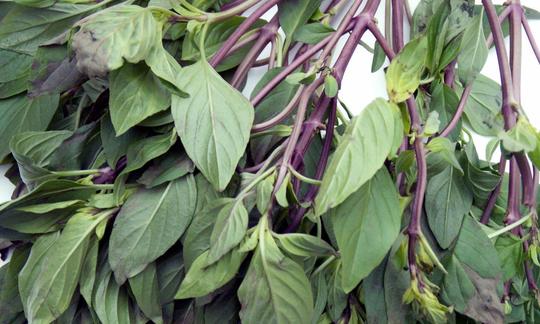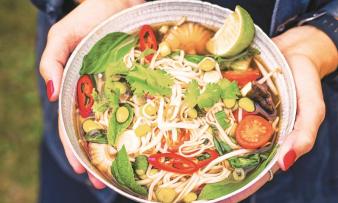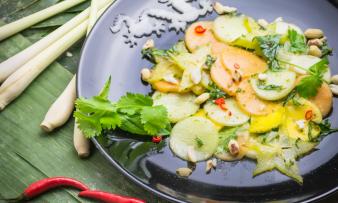Table of contents
From a botanical point of view, Horapa ( Ocimum basilicum var. thyrsiflora ) is a variety of the basil plant ( Ocimum basilicum ) which is widespread in Europe. Along with Krapao basil (also: Kaprao) and Maenglak, raw Horapa basil is one of the most commonly used basil species in Thai cuisine.
Thai basil: Using Horapa in the kitchen
How can Thai basil be classified in terms of taste? Horapa or Thai basil has an intensely aromatic-sweet to spicy-peppery taste and has an anise-like scent. Depending on the variety, the raw spice (in contrast to European basil ) is also reminiscent of liquorice, allspice or cinnamon . 1 The basil variety is widely used in Southeast Asian cuisine as Bai Horapa . You can read about other possible names in the chapters Purchasing and Possible Confusion.
Vietnamese, Laotian, Cambodian and Thai recipes with Thai basil include green and red curries, pho (noodle soups), wok dishes and hot and sour or sweet and sour dishes. In Vietnam, Horapa basil is served raw as a garnish with food.
Another possible use of Horapa is to season soups, sauces, salads, glass noodles, rice, pestos or desserts. The fresh leaves and flowering shoots can be sprinkled raw over ready-made dishes or added at the end of the cooking time, as heat causes the aroma to evaporate. The raw flowers make an attractive decoration on dishes and plates.
Thanks to its aniseed and licorice-like aroma, Horapa basil harmonizes well with fresh coriander leaves , raw parsley , mint (e.g. Moroccan mint ), lemongrass or other Asian spices. If Thai basil is not on hand, you can use aniseed sparingly as an alternative.
The seeds of Thai basil can be grown into fresh sprouts and used in raw food cooking.
Vegan recipe for fresh orange juice with Horapa:
Ingredients (for two people): Juice of 6 organic oranges , freshly squeezed and with pieces of fruit; juice of ½ organic lemon , freshly squeezed; 1 cinnamon stick ; 5 cloves ; lemon peel of ½ organic lemon, finely chopped; raw leaves of 3 Thai basil stalks (organic), freshly chopped.
Preparation: First, pour the fresh orange juice into a glass or metal container and add all the other flavoring ingredients. Cover and leave the mixture in the fridge overnight. After at least 8 hours, strain the juice and serve it as a vegan drink in two large glasses over ice.
Recipe for tea with Horapa (fresh):
Fresh or dried leaves of Thai basil (organic) are suitable for preparing a spicy tea with a subtle aniseed note. For the Thai basil recipe, pour 250 ml of drinking water over a few raw leaves or a teaspoon of dried leaves. Allow the tea to steep for 5-7 minutes and enjoy it fresh.
Vegan recipes with Horapa (Thai basil) can be found under the note: " Recipes that have the most of this ingredient ".
| Not only vegans or vegetarians should read this: Vegans often eat unhealthily. Avoidable nutritional mistakes . |
Purchasing - where to buy Horapa?
Thai basil Horapa can be bought frozen, dried or fresh as raw food quality (raw quality) in Asian markets or online. Thai Horapa is available as seeds or organic pot plants in specialist agricultural and horticultural shops, in the plant department of hardware stores or in garden centers. Cultivated varieties are 'Albahaca tailandesa', 'Horapa Rau Que', 'Queenette', 'Thai Magic', 'Thai Red' or 'Thai Sweet'. Thai basil is in season almost all year round in stores, except in winter.
In supermarkets such as Coop , Migros , Denner , Volg , Spar , Aldi , Lidl , Rewe , Edeka or Hofer as well as in the organic supermarkets Denn's Biomarkt or Alnatura we have so far found neither conventional Thai basil nor products of organic quality (organic).
In German, Horapa is colloquially called Thai basil or sweet basil. In English, however, sweet basil is a common alternative name for European basil ( Ocimum basilicum ). The variety Horapa ( Ocimum basilicum var. thyrsiflora ) is also sometimes called sweet basil, but to distinguish it is more often called sweet Thai (Sweet Thai Basil).
Found in the wild:
Ocimum basilicum var. thyrsiflora is native to Southeast Asia. It can be found growing wild in tropical and subtropical regions. Outside of these zones, Thai basil can only grow wild in very warm climates with no chance of frost. The plant needs 6-8 hours of full sunlight per day. 4.11 With a little luck, Thai basil can be found growing wild in the Mediterranean region.
Horapa basil grows upright, bushy and densely branched and reaches a height of up to 45 cm. The narrow, slightly serrated leaves are shiny dark green, sometimes with a purple tint and are crossed by clearly visible leaf veins. The red stems are a characteristic identifying feature of the plant. The purple inflorescence is a tall, reddish main axis with pink flower clusters branching off to the sides. 2,3,4,5
Storing Thai basil:
Ideally, Horapa should be used freshly picked. Alternatively, you can put the Thai basil in a raw bunch in a glass of water and store it at room temperature for a few days. The herb will stay fresh for up to a week if you cut off some of the stems, put them in water, cover the leaves with a plastic bag and store them in the fridge.
Can you freeze Thai basil? For long-term storage of up to three months, you can freeze the picked basil leaves, together with the buds, in the freezer. Avoid washing the leaves beforehand, as this could lead to a loss of flavor.
Should you freeze or dry Thai basil? Unlike freezing, drying the leaves is not a generally suitable method of preservation because it causes them to lose a lot of their aroma. 14
Ingredients - calories - nutritional values:
Here we realistically show you the ingredients of spices and herbs per 1 g (instead of per 100 g as usual).
The calorie content of 1 g of raw Thai basil ( Ocimum basilicum var. thyrsiflora ) is 0.41 kcal. The same amount of herb naturally contains 0.16 mg of sodium or 0.4 mg of table salt. 6
Similar salt values per 1 g can be found in other herbs such as spring onions (0.41 mg), raw wild garlic (0.41 mg) or savory clover (0.4 mg). In comparison, 1 g of raw basil ( Ocimum basilicum ) contains 0.04 mg of sodium or 0.1 mg of salt. Significantly higher levels of salt (mg/1g) can be found in raw celery (2.03 mg), dandelion leaves (1.93 mg) or fresh parsley (1.42 mg). 6,7
In addition to less than 0.01 g of fat per gram, 0.08 g of carbohydrates (of which 0.03 g of fiber) and 0.03 g of protein, raw Horapa consists mainly of water. 6,7 We do not have reliable information on other nutrients in Thai basil ( Ocimum basilicum var. thyrsiflora ).
The complete ingredients of fresh Thai basil (Horapa), the coverage of the daily requirement and comparison values with other ingredients can be found in our nutrient tables in CLICK FOR below the ingredients picture.
Health aspects - effects:
Is Thai basil healthy or unhealthy? and Does Thai basil have an effect on health? Results of a laboratory analysis of three Ocimum basilicum varieties showed that Ocimum basilicum var. thyrsiflora has the highest antioxidant and antibacterial effects. Ocimum basilicum has a great potential to neutralize free radicals and high inhibition rates against Staphylococcus aureus . 8
Dangers - intolerances - side effects:
Thai basil contains essential oil with various components, including linalool and estragole. Various studies have shown very different levels. 8,13,15 You can find out more about the estragole issue under the same subtitle of the ingredient basil, fresh (organic?) . According to "Wichtl - Teedrogen und Phytopharmaka", there is no acute danger from estragole-dominated basil species, but for safety reasons one should refrain from using them as a medicinal remedy. 9
The Aargau Office for Consumer Protection states in its 2020 annual report that nine out of ten imported vegetable and fruit samples from Asia contained residues of 1-9 different active ingredients at the same time. Of these, four samples were rejected for exceeding the maximum residue level - including sweet basil (Horapa). 10
Occurrence - Origin:
The original distribution area of Horapa (Horapha, Horopa, Horappa, Horrapa, Hurapa) is not known for sure. It is thought to have originated in India, as the plants growing wild there are most closely related to basil. West Asia could be another possible place of origin, as Thai basil has been known there for more than 3,000 years. Today it is widespread in Southeast Asia.
Cultivation in the garden or as a potted plant:
Horapa can be propagated by sowing the seeds in the spring directly in the garden or as a pre-culture indoors. Cuttings can be propagated by placing cut shoots in a glass of water and allowing them to grow roots.
Horapa requires moderately nutrient-rich and permeable soil with a pH value between 6.5 and 7.5. Does basil need hours of sunshine? The location should be sheltered from the wind and sunny so that the plant receives six to eight hours of full sunlight per day. Horapa does not tolerate waterlogging. Cutting the stems instead of plucking the leaves encourages the rejuvenation of the plant and thus promotes the growth structure. 4,11 Flowers should be removed, otherwise the leaves can take on a bitter taste.
Thai basil is perennial, but as a tropical plant it cannot tolerate frost. If you want to grow Horapa in cooler regions, you must overwinter the plant in a bright, warm place, e.g. on the windowsill in the house.
Possible confusion:
We are not aware of any cases of Horapa basil being confused with poisonous plants. It is possible that the numerous types and varieties of basil cannot always be clearly identified (similar appearance).
There is a possibility of confusion with species that are also known as Thai basil or Thai basil (Thai basil) . However, these differ greatly in taste and appearance from Horapa basil. Krapao and Maenglak (own basil species) are particularly worth mentioning.
- Krapao or Kaprao ( Ocimum tenuiflorum syn. Ocimum sanctum L.) is known colloquially as Bai Krapao, Tulsi, Tulasi, Indian basil, small basil, royal basil or holy basil. The plant originally comes from tropical and subtropical Asia and northern Australia. Its appearance is often characterized by its purple stems, reddish leaf veins and purple-pink flowers. The variety 'Purple' syn. 'Krishna Tulsi' has a distinct purple color and a sweet taste reminiscent of cloves or allspice. In the kitchen, Tulsi (Kaprao or Krapao leaves) is known as a tea and spice, e.g. in hearty wok dishes. 12
- Maenglak ( Ocimum × citriodorum ) is also called Bai Maenglak or camphor basil and has an intense citrus scent. O. citriodorum is a natural hybrid of O. americanum syn. O. canum Sims (lemon basil) and O. basilicum and is found in Southeast Asia and Northeast Africa. The thin leaves are narrowly egg-shaped, the flowers are small and white. O. americanum grows naturally in tropical and southern Africa, in Madagascar, as well as in India, Sri Lanka and China. In folk medicine, the plant is used internally for fever, dysentery and malaria 12 and in the kitchen for fish, soups, drinks and herbal vinegar.
In English, the common basil in Europe (European 13 ) ( Ocimum basilicum ) is often called sweet basil . Since Thai basil is a variety of this species ( Ocimum basilicum var. thyrsiflora ), this alternative name can also apply to it and also cause confusion (Sweet Basil or Sweet Thai Basil, Sweet Thai = Sweet Basil or Sweet Thai Basil).
General information:
Horapa or Thai basil (Latin name: Ocimum basilicum var. thyrsiflora ) is botanically a variety of the basil species Ocimum basilicum, which is widespread in Europe, from the genus Basil ( Ocimum ) of the same name and belongs to the mint family. In contrast, other spice plants known as Thai basil are separate basil species that also have a different spectrum of active ingredients. 8,9,13,15
Alternative names for Thai basil:
Horapa is alternatively called Bai Horapa (Horapha, Horopa, Horappa, Horrapa, Hurapa), Thai Horapa (Horapa Thai), Thai basil (incorrect spelling: Thai basil / Thai), Thai basil, Thai basil, Queen of Siam, Sweet Thai basil or Sweet basil (Sweet basil - see possible confusion).
The English name is: Horapa Basil, Sweet Thai Basil, Sweet Thai, Sweet Basil; the French name is: Basilic Thai. Basil Spanish: albahaca.
Literature - Sources:








Comments